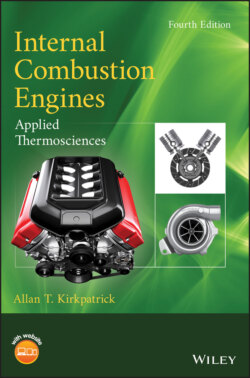Читать книгу Internal Combustion Engines - Allan T. Kirkpatrick - Страница 34
Cooling Systems
ОглавлениеSome type of cooling system is required to remove the approximately 30% of the fuel energy rejected as waste heat. Liquid and air cooling are the two main types of cooling systems. The liquid cooling system (see Figure 1.17) is usually a single loop where a water pump sends coolant to the engine block, and then to the head. Warm coolant flows through the intake manifold to warm it and thereby assist in vaporizing the fuel. The coolant will then flow to a radiator or heat exchanger, reject the waste heat to the atmosphere, and flow back to the pump. When the engine is cold, a thermostat prevents coolant from returning to the radiator, resulting in a more rapid warmup of the engine. Liquid‐cooled engines are quieter than air‐cooled engines, but have leaking, boiling, and freezing problems. Engines with relatively low power output, less than 20 kW, primarily use air cooling. Air‐cooling systems use fins to lower the air side surface temperature (see Figure 1.18). There are historical examples of combined water and air cooling. The Mors, an early 1920s automobile, had a finned air‐cooled cylinder and water‐cooled heads.
Figure 1.17 Liquid cooling system schematic.
Figure 1.18 Air cooling of model airplane engine. (Courtesy R. Schroeder.)
